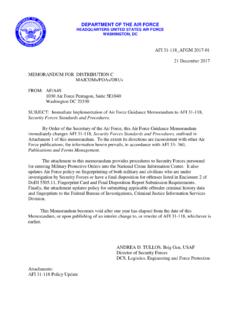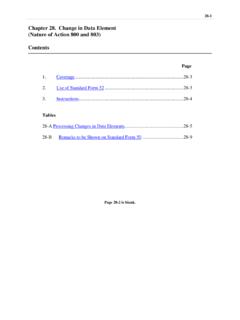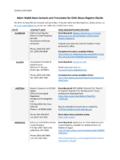Transcription of Mechanical Response of Polycarbonate with …
1 Mechanical Response of Polycarbonate with strength Model Fits by Ajmer Dwivedi, Jermaine Bradley, and Daniel Casem ARL-TR-5899 February 2012 Approved for public release; distribution is unlimited. NOTICES Disclaimers The findings in this report are not to be construed as an official Department of the Army position unless so designated by other authorized documents. Citation of manufacturer s or trade names does not constitute an official endorsement or approval of the use thereof. Destroy this report when it is no longer needed. Do not return it to the originator. Army Research Laboratory Aberdeen Proving Ground, MD 21005-5069 ARL-TR-5899 February 2012 Mechanical Response of Polycarbonate with strength Model Fits Ajmer Dwivedi and Jermaine Bradley Dynamic Science, Inc.
2 Daniel Casem Weapons and Materials Research Directorate, ARL Approved for public release; distribution is unlimited. ii REPORT DOCUMENTATION PAGE Form Approved OMB No. 0704-0188 Public reporting burden for this collection of information is estimated to average 1 hour per Response , including the time for reviewing instructions, searching existing data sources, gathering and maintaining the data needed, and completing and reviewing the collection information. Send comments regarding this burden estimate or any other aspect of this collection of information, including suggestions for reducing the burden, to Department of Defense, Washington Headquarters Services, Directorate for Information Operations and Reports (0704-0188), 1215 Jefferson Davis Highway, Suite 1204, Arlington, VA 22202-4302.
3 Respondents should be aware that notwithstanding any other provision of law, no person shall be subject to any penalty for failing to comply with a collection of information if it does not display a currently valid OMB control number. PLEASE DO NOT RETURN YOUR FORM TO THE ABOVE ADDRESS. 1. REPORT DATE (DD-MM-YYYY) February 2012 2. REPORT TYPE Final 3. DATES COVERED (From - To) October 2010 October 2011 4. TITLE AND SUBTITLE Mechanical Response of Polycarbonate with strength Model Fits 5a. CONTRACT NUMBER W911QX-09-C-0057 5b. GRANT NUMBER 5c. PROGRAM ELEMENT NUMBER 6. AUTHOR(S) Ajmer Dwivedi, Jermaine Bradley , and Daniel Casem 5d. PROJECT NUMBER 5e. TASK NUMBER 5f. WORK UNIT NUMBER 7.
4 PERFORMING ORGANIZATION NAME(S) AND ADDRESS(ES) Army Research Laboratory ATTN: RDRL-WMP-B Aberdeen Proving Ground, MD 21005-5069 8. PERFORMING ORGANIZATION REPORT NUMBER ARL-TR-5899 9. SPONSORING/MONITORING AGENCY NAME(S) AND ADDRESS(ES) 10. SPONSOR/MONITOR S ACRONYM(S) 11. SPONSOR/MONITOR'S REPORT NUMBER(S) 12. DISTRIBUTION/AVAILABILITY STATEMENT Approved for public release; distribution is unlimited. 13. SUPPLEMENTARY NOTES Dynamic Science, Inc., 1003 Old Philadelphia Rd., Ste. 210, Aberdeen, MD 21001 14. ABSTRACT Experiments were conducted on Polycarbonate to investigate how the material responds mechanically at varying deformation rates and elevated temperatures. The data was then used to determine parameters for the Johnson-Cook strength model and the Zerilli-Armstrong polymer strength model.
5 Quasi-static tests were conducted at strain rates between and using a servo-hydraulic load frame. Dynamic compression experiments were performed using the Split Hopkinson Pressure Bar and resulted in strain rates between 1750/s and 15,000/s. Pre-heated specimens were tested in both setups to determine the effects of thermal softening. The results indicate that the material Response is rate sensitive with an enhanced hardening at rates greater than 10/s. Predictably, tests conducted at elevated temperatures cause a decrease in the apparent yield and flow stress. Model fits to the data are shown to provide a reasonable approximation of real world behavior. 15. SUBJECT TERMS transparent materials, rate effect, temperature effect, polymer Polycarbonate , polymer testing, kolsky bar, polymer modeling, plastic 16.
6 SECURITY CLASSIFICATION OF: 17. LIMITATION OF ABSTRACT UU 18. NUMBER OF PAGES 32 19a. NAME OF RESPONSIBLE PERSON Ajmer Dwivedi a. REPORT Unclassified b. ABSTRACT Unclassified c. THIS PAGE Unclassified 19b. TELEPHONE NUMBER (Include area code) 410-306-0790 Standard Form 298 (Rev. 8/98) Prescribed by ANSI Std. iii Contents List of Figures iv List of Tables v Preface vi Acknowledgments vii 1. Introduction 1 2. Material 1 3. Experimental Procedures 2 Low Rate Compression and High Rate 4. Results 4 Low Rate and High Rate Compression at Room Temperature ..4 Compression at Elevated Temperatures ..6 Low and High Rate Tension ..8 5. Constitutive Modeling 9 6. Discussion and Conclusion 12 7.
7 References 14 List of Symbols, Abbreviations, and Acronyms 17 Distribution List 18 iv List of Figures Figure 1. Dimensioned drawing of the tension specimen..3 Figure 2. Representative stress strain curves from low rate experiments..4 Figure 3. Representative stress strain curves from SHPB compression tests..5 Figure 4. Yield stress as a function of strain rate. Extrapolation of linear fits (dotted) suggest a transition to enhanced hardening at ~10/s..6 Figure 5. Results from compression tests at elevated temperatures..7 Figure 6. Yield stress as a function of temperature..7 Figure 7. Results from low rate tension experiments..8 Figure 8. Neck propagation in straight tension specimens..9 Figure 9.
8 Comparison of JC calculations to experimental data..11 Figure 10. Comparison of ZA calculations to experimental data..12 v List of Tables Table 1. Material properties for PC. aDenotes value calculated by Millet and Bourne (6)..2 Table 2. JC parameters..10 Table 3. ZA model parameters..11 vi Preface This report is the result of a collaborative effort between government and contractor personnel. Ajmer Dwivedi of Dynamic Science, Inc. (DSI) and Jermaine Bradley (DSI) conducted the experiments and performed data analysis. Daniel Casem was responsible for selecting appropriate constitutive models and accordingly designing experiments that would generate the necessary data. vii Acknowledgments The authors would like to thank Stephen Whittie (ORISE) and David Gray (RDRL-WMM-B) for their assistance setting up digital photography and operating servo hydraulic test platforms.
9 Viii INTENTIONALLY LEFT BLANK. 1 1. Introduction One of the most important applications for amorphous polymers is in transparent armor packages. Typically, these systems consist of alternating glass and transparent polymer layers. The glass serves to deform and fracture the threat while the polymer layer acts as a spall shield (1, 2). Polycarbonate (PC) is a material that has high ductility and low density, making it a good candidate for use in these packages. PC is also being considered for several specialized applications because it has the potential to offer significant weight savings and better protection against relevant threats. To support ongoing research in these areas, experiments were conducted on PC to characterize its Mechanical Response .
10 The experiments performed as part of this study were used to determine material constants for constitutive models. These include uniaxial stress compression at both low and high rates as well as elevated temperatures. Low rate experiments (<1/s) were performed with a servo-hydraulic load frame and high rate tests (~103/s) with the Split Hopkinson Pressure Bar (SHPB) or Kolsky Bar technique. These experiments were supplemented with low rate tensile tests. Material constants were calculated for the Johnson Cook (JC) strength model and the Zerilli Armstrong (ZA) polymer constitutive model (3 5). 2. Material The specimens used in this study were machined from a thick Bayer MAKROLON General Purpose cast Polycarbonate plate.















